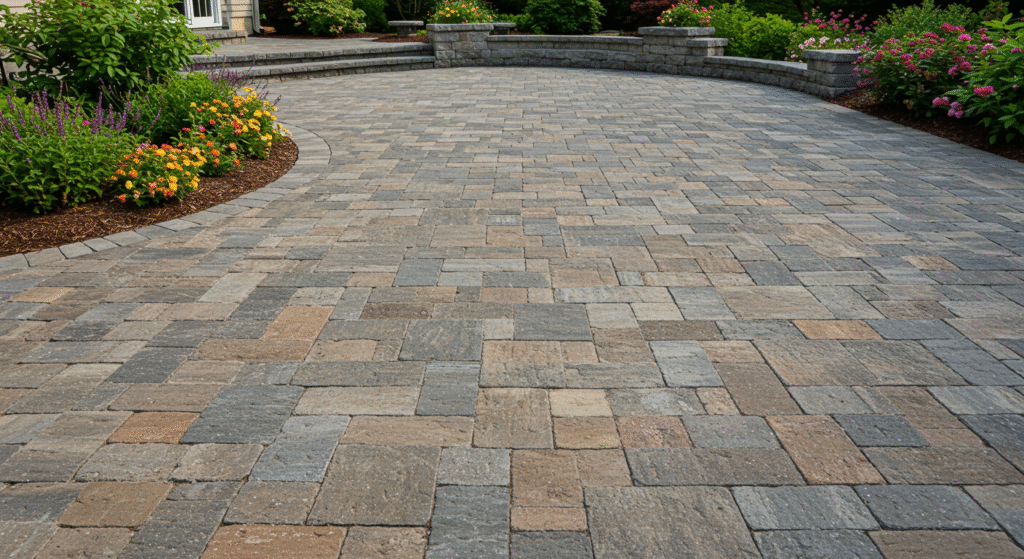A well-designed paver patio can transform your outdoor space into a luxurious and functional retreat. Whether you use it for backyard barbecues, relaxing weekends, or elegant garden parties, a patio adds value and charm to your home. However, over time, many homeowners face a frustrating issue—paver patio shifting.
Shifting pavers not only affect the appearance of your patio but also pose safety risks, drainage problems, and long-term structural issues. The good news? These problems are entirely preventable when you work with skilled professionals and follow time-tested practices. At Viking Pavers, we specialize in creating long-lasting, stable paver patios that stand the test of time—even in challenging climates.
In this comprehensive guide, we’ll explain why shifting paver patios occur and share proven solutions on how to prevent your paver patio from shifting over time.
Why Do Pavers Shift?
Before diving into prevention methods, it’s essential to understand what causes pavers to move. At Viking Pavers, we’ve spent years studying and repairing patios with stability issues. Our findings point to a combination of factors that contribute to paver patio shifting:
1. Poor Base Preparation
If the base beneath the pavers is too shallow, uneven, or improperly compacted, the entire structure becomes vulnerable to settling and shifting over time. The base must be deep enough for the patio’s intended use—especially in areas with heavy foot traffic or outdoor furniture.
2. Weak or No Edge Restraints
Pavers need to be contained with solid edge restraints. Without a strong border, the outer pavers can shift outward, leading to a ripple effect that disrupts the entire layout.
3. Improper Bedding Layer
The layer of sand beneath the pavers—known as bedding sand—must be applied in a consistent, compacted manner. If it’s too thick or loosely installed, pavers can settle unevenly or shift under weight.
4. Weather and Erosion
Rain, freeze-thaw cycles, and poor drainage can wash away the sand or base materials beneath your patio, leading to dips, gaps, or movement.
5. Human Error in Installation
Even high-quality materials can’t compensate for rushed or inexperienced installation. A lack of attention to detail during the construction process often leads to premature problems.
Proven Solutions to Prevent Shifting Pavers
Now that we understand the causes, let’s look at how Viking Pavers ensures a stable, beautiful patio that doesn’t shift—season after season.
1. Start with the Right Excavation and Base Depth
One of the most critical steps is properly preparing the base. At Viking Pavers, we begin every project with thorough excavation to a depth suited to your soil conditions and patio usage. Typically, we recommend:
- 4 inches for pedestrian-only patios
- 6–8 inches for driveways or patios supporting furniture and fire pits
Once excavated, we add a crushed stone or Class II road base layer and compact it with professional-grade plate compactors to eliminate air pockets.
2. Install Strong Edge Restraints
To prevent your pavers from drifting outward, we install high-quality edge restraints around the perimeter of your patio. These can be made of plastic, concrete, or metal, and are secured tightly to the base. A properly edged patio is critical to long-term structural integrity and is one of the best defenses against a shifting paver patio.
3. Lay and Compact the Bedding Sand
The bedding layer is a thin (usually 1-inch) layer of concrete sand or washed angular sand that sits atop the compacted base. Our team ensures it is:
- Screeded evenly
- Properly compacted before laying pavers
- Not too thick or inconsistent
This layer acts as a cushion and ensures the pavers rest securely.
4. Use Interlocking Patterns for Strength
Did you know your paver pattern can impact stability? Interlocking patterns like herringbone or basket weave distribute weight more effectively and are less likely to shift than simple stack bond patterns. Viking Pavers can help you choose a design that’s both visually appealing and structurally sound.
5. Final Compaction and Joint Sand Application
After the pavers are laid, we run a plate compactor over the surface to lock them into place. Then, we fill the joints with polymeric sand, which hardens when moistened. This not only keeps pavers from moving but also:
- Prevents weeds
- Deters ants
- Improves drainage
The final compaction is often overlooked in DIY installations, but it’s absolutely essential to preventing long-term shifting.
Regular Maintenance Tips to Keep Pavers in Place
Even the best installations benefit from occasional maintenance. To prevent problems from developing over time:
- Inspect seasonally: Look for signs of movement, erosion, or loose joints.
- Reapply joint sand: As needed, top off joints with polymeric sand to keep the patio tight.
- Control weeds: Pull weeds early before they displace joint sand or pavers.
- Clean properly: Avoid using high-pressure washers that can erode the sand or base beneath the pavers.
With simple upkeep, your patio can last decades without major issues.
What to Do If Your Pavers Are Already Shifting
If your patio is already showing signs of instability—such as uneven surfaces, separating joints, or sinking corners—it’s important to act fast. The longer you wait, the more damage can occur.
At Viking Pavers, we offer professional repair and restoration services. Our team can:
- Remove and reset shifting pavers
- Reinforce the base
- Replace joint sand
- Improve drainage where needed
We’ll also identify and correct the underlying issues that caused the problem in the first place, ensuring your patio stays level and secure going forward.
Why Viking Pavers?
At Viking Pavers, we specialize in high-quality, long-lasting hardscape solutions. From design and installation to repair and maintenance, we’re your trusted partner in outdoor living. Our proven methods and commitment to excellence have made us a go-to choice for homeowners who want patios that are both beautiful and built to last.
What sets us apart:
- Experienced craftsmanship
- Premium materials
- Meticulous attention to detail
- Guaranteed satisfaction
We know how to prevent your paver patio from shifting over time, and we apply that knowledge to every project we complete.
Final Thoughts: Build It Right, Enjoy It Longer
There’s no reason to live with the frustration of a shifting paver patio. Whether you’re planning a new patio or repairing an old one, the key to long-term stability is a solid foundation, proper installation, and occasional maintenance. With Viking Pavers, you can say goodbye to shifting pavers—and hello to a patio that looks great and performs perfectly for years to come.
Ready to stabilize your patio for good? Contact Viking Pavers today for a free consultation and start building with confidence.










More Stories
Need Drain Cleaning or Water Heater Repair in San Lorenzo? Call Smart Choice Plumbing Anytime
Principal Residence Exemption vs. U.S. §121 Exclusion: How Canadians Moving South Can Sell Their Homes Tax‑Efficiently
Shell Decor: How to Add Natural Elegance to Your Home with Coastal Touches